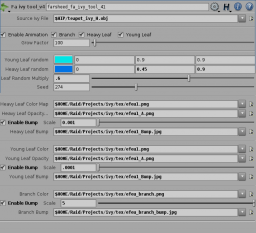Search the Community
Showing results for tags 'C++'.
-
My First Try in Houdini HDK Customized the houdini file handler helper to accept custom paths. Python script integrated into Cpp to solve asset/shot logic. Still need to improvise a lot for production release . #houdini #hdk #c++ #python Cheers!!
-
Hi everyone! I recently started working with the HDK and have been trying to set my project up to use an external library, but I don't have a lot of experience with dependency management in C++. It seemed to me like setting something up with a cmake file was the way to go, but I'm having a hard time figuring out the best way to set something up to work with the Houdini environment. Is this something that is even possible, or am I going about this the wrong way? Thanks!
-
Greetings! I have recently started using the hdk to build a custom plug-in (which consist of a SOP Node that modify a heightfield) and I have encountered a deadend (actually more than one, but this forum provided me a lot of help ^^) In a few words, I am creating a SpareParm by getting the OP_Director (OPgetDirector()) and adding a PRM_Template with method addNodeSpareParm(). My issue is that if I provide a callback function, it is not called back (no result and in debug mode, any breakpoints in the callback function are never reached). I have no issue with parameters normally given when creating the node (I mean when using the newSopOperator() function, a button parameter call back its function correctly). To fully explain my process: I am creating a node with a path parameter (PRM_File) where I can provide a custom file. This custom file is read and depending on its content, I need to add parameters to the node. From my researches, SpareParms were the only approach suitable. Maybe I am wrong and I will be grateful if you can point me in the direction of a better method. For instance, this file could give me the parameter ‘width’ with a range and the node would create an integer parameter that would make possible to change the width of the input heightfield. But the SpareParms that are created do not seem to call the cookMySop() function when modified and adding a callback function that would use the forceRecook() function is not called (as explain above). Does this issue ring any bell? Thanks in advance Luc
-
Hi, I am programmatically generating Houdini scene (HIP) files After creating and connecting nodes, I'd like to perform a layout and home so that when the user open up the scene, it is not one ball of nodes in the center. Is there a way to do that in Hython calls, what about C++ ? Cheers
-
hello everyone,i'm learning c++ and I'm new to Houdini HDK. I was reading another topic, someone told that you can use example files and manipulate them. so I have some questions for you: as you can see the header code and it's definition namespace HDK_Sample { /// Run a sin() wave through geometry by deforming points /// @see @ref HOM/SOP_HOMWave.C, SOP_HOMWave, SOP_CPPWave class SOP_PointWave : public SOP_Node { public: SOP_PointWave(OP_Network *net, const char *name, OP_Operator *op); virtual ~SOP_PointWave(); static PRM_Template myTemplateList[]; static OP_Node *myConstructor(OP_Network*, const char *, OP_Operator *); /// This method is created so that it can be called by handles. It only /// cooks the input group of this SOP. The geometry in this group is /// the only geometry manipulated by this SOP. virtual OP_ERROR cookInputGroups(OP_Context &context, int alone = 0); protected: /// Method to cook geometry for the SOP virtual OP_ERROR cookMySop(OP_Context &context); private: void getGroups(UT_String &str){ evalString(str, "group", 0, 0); } fpreal AMP(fpreal t) { return evalFloat("amp", 0, t); } fpreal PHASE(fpreal t) { return evalFloat("phase", 0, t); } fpreal PERIOD(fpreal t) { return evalFloat("period", 0, t); } /// This is the group of geometry to be manipulated by this SOP and cooked /// by the method "cookInputGroups". const GA_PointGroup *myGroup; }; using namespace HDK_Sample; void newSopOperator(OP_OperatorTable *table) { table->addOperator(new OP_Operator( "hdk_pointwave", "Point Wave", SOP_PointWave::myConstructor, SOP_PointWave::myTemplateList, 1, 1, 0)); } static PRM_Name names[] = { PRM_Name("amp", "Amplitude"), PRM_Name("phase", "Phase"), PRM_Name("period", "Period"), }; PRM_Template SOP_PointWave::myTemplateList[] = { PRM_Template(PRM_STRING, 1, &PRMgroupName, 0, &SOP_Node::pointGroupMenu, 0, 0, SOP_Node::getGroupSelectButton( GA_GROUP_POINT)), PRM_Template(PRM_FLT_J, 1, &names[0], PRMoneDefaults, 0, &PRMscaleRange), PRM_Template(PRM_FLT_J, 1, &names[1], PRMzeroDefaults), PRM_Template(PRM_FLT_J, 1, &names[2], PRMoneDefaults), PRM_Template(), }; OP_Node * SOP_PointWave::myConstructor(OP_Network *net, const char *name, OP_Operator *op) { return new SOP_PointWave(net, name, op); } SOP_PointWave::SOP_PointWave(OP_Network *net, const char *name, OP_Operator *op) : SOP_Node(net, name, op), myGroup(NULL) { mySopFlags.setManagesDataIDs(true); } SOP_PointWave::~SOP_PointWave() {} OP_ERROR SOP_PointWave::cookInputGroups(OP_Context &context, int alone) { return cookInputPointGroups( context, // This is needed for cooking the group parameter, and cooking the input if alone. myGroup, // The group (or NULL) is written to myGroup if not alone. alone, // This is true iff called outside of cookMySop to update handles. // true means the group will be for the input geometry. // false means the group will be for gdp (the working/output geometry). true, // (default) true means to set the selection to the group if not alone and the highlight flag is on. 0, // (default) Parameter index of the group field -1, // (default) Parameter index of the group type field (-1 since there isn't one) true, // (default) true means that a pointer to an existing group is okay; false means group is always new. false, // (default) false means new groups should be unordered; true means new groups should be ordered. true, // (default) true means that all new groups should be detached, so not owned by the detail; // false means that new point and primitive groups on gdp will be owned by gdp. 0 // (default) Index of the input whose geometry the group will be made for if alone. ); } OP_ERROR SOP_PointWave::cookMySop(OP_Context &context) { OP_AutoLockInputs inputs(this); if (inputs.lock(context) >= UT_ERROR_ABORT) return error(); duplicatePointSource(0, context); fpreal t = context.getTime(); float phase = PHASE(t); float amp = AMP(t); float period = PERIOD(t); if (error() >= UT_ERROR_ABORT) return error(); if (cookInputGroups(context) >= UT_ERROR_ABORT) return error(); GA_Offset ptoff; GA_FOR_ALL_GROUP_PTOFF(gdp, myGroup, ptoff) { UT_Vector3 p = gdp->getPos3(ptoff); p.y() += SYSsin( (p.x() / period + phase) * M_PI * 2 ) * amp; gdp->setPos3(ptoff, p); } if (!myGroup || !myGroup->isEmpty()) gdp->getP()->bumpDataId(); return error(); } my first question is: we have this int header file : SOP_PointWave(OP_Network *net, const char *name, OP_Operator *op); where is it's definition in *.c file? ----------------------------------------------------------------------------------------------------------------------------------------- my second question is: void newSopOperator(OP_OperatorTable *table) { table->addOperator(new OP_Operator( "hdk_pointwave", "Point Wave", SOP_PointWave::myConstructor, SOP_PointWave::myTemplateList, 1, 1, 0)); } why this function is void? I know because it won't return anything, but why it shouldn't? why newSopOperator's parameter is a class (i know a class is custom data type) but why? and what is table in the parameter? ----------------------------------------------------------------- BEST REGARDS
-
hello, nowadays I'm working on Houdini HDK I created a discord server to help each other this is the discord's link: https://discord.gg/RtNRscp and this is my blog:https://aminkhormaei1.wixsite.com/base i put solutions inside my blog. please share this post, maybe your friends are into developing a plugin for Houdini BEST REGARDS
-
Good day everyone, for our current project (in the scale of 7 people, 4 months), we are trying to implement a sequencer into Houdini that was built with the audio-programming tool called JUCE (https://juce.com/). Essentially, this is just a library to create audio tools in C++ through a graphical interface. Now currently, my audio programming colleague built a sequencer for our project that allows us to accumulatingly, randomly assign sounds from a library to the slots in the sequencer which then get played back. The goal of this implementation is to tell the sequencer which objects of my simulation are currently in frame and then feed this list of objects to the sequencer. The sequencer then builds a structure of playback and outputs which objects get triggered when in order to play their animation. Ideally, I will use the HDK to implement this code (while linking the custom libraries of JUCE) and have this run as a plugin inside Houdini. I do have a somewhat of a background in programming (but not with C++) and a long history with Houdini, but this undertaking exceeds my capabilities. What I am looking for is advice on where to even get started in tackling such an implementation or plugin building in general. (And if this undertaking is even doable.) Unfortunately the HDK documentation is already a little too advanced for me and I couldn't find a way into the subject matter. I would be very grateful for any help. Cheers, Martin
-

VEX_Sort not working in 16.0.736 (Solved)
wandersonp posted a topic in HDK : Houdini Development Kit
Hey guys the original example from VEX_Sort is not working at least in my windows machine I change the code #include <UT/UT_DSOVersion.h> #include <UT/UT_Array.h> #include <UT/UT_Vector3.h> #include <UT/UT_Vector4.h> #include <UT/UT_Matrix3.h> #include <UT/UT_Matrix4.h> #include <UT/UT_Assert.h> #include <VEX/VEX_VexOp.h> using namespace UT::Literal; namespace HDK_Sample { template <typename T> int compareValues(const T *a, const T *b) { if (*a < *b) return -1; if (*a > *b) return 1; return 0; //Direct access to pointer value is not working in compare operator //return *a > *b; } template <> int compareValues<const char *>(const char * const *a, const char * const *b) { return strcmp(*a, *b); } template <> int compareValues<UT_Vector3>(const UT_Vector3 *a, const UT_Vector3 *b) { if (a->length2() < b->length2()) return -1; if (a->length2() > b->length2()) return 1; return 0; //Direct access to pointer value is not working in compare operator //return a->length2() > b->length2(); } template <> int compareValues<UT_Vector4>(const UT_Vector4 *a, const UT_Vector4 *b) { if (a->length2() < b->length2()) return -1; if (a->length2() > b->length2()) return 1; return 0; //Direct access to pointer value is not working in compare operator //return a->length2() > b->length2(); } template <> int compareValues<UT_Matrix3>(const UT_Matrix3 *a, const UT_Matrix3 *b) { if (a->determinant() < b->determinant()) return -1; if (a->determinant() > b->determinant()) return 1; return 0; //Direct access to pointer value is not working in compare operator //return a->determinant() > b->determinant(); } template <> int compareValues<UT_Matrix4>(const UT_Matrix4 *a, const UT_Matrix4 *b) { if (a->determinant() < b->determinant()) return -1; if (a->determinant() > b->determinant()) return 1; return 0; //Direct access to pointer value is not working in compare operator //return a->determinant() > b->determinant(); } template <typename T> static void sort(int argc, void *argv[], void *) { UT_Array<T> *arr = (UT_Array<T> *)argv[0]; // This will work with all types (including strings). Since no strings // are created or destroyed by this method, it's not necessary to call // VEX_VexOp::stringAlloc() or VEX_VexOp::stringFree() to free them - // the pointers are just reordered in the array. arr->sort(compareValues<T>); } static void decimate(int argc, void *argv[], void *) { const UT_Array<const char *> &src = *(UT_Array<const char *> *)argv[1]; UT_Array<const char *> &dst = *(UT_Array<const char *> *)argv[0]; UT_ASSERT(dst.entries() == 0); for (int i = 0; i < src.entries() / 2; i++) { // Acquire a new reference to the string for storage in the // destination array. const char *str = VEX_VexOp::stringAlloc(src(i * 2)); dst.append(str); } } } // // Installation function // using namespace HDK_Sample; void newVEXOp(void *) { // Sort the array by value for scalars, length for vectors, or // determinant for matrices. new VEX_VexOp("hdksort@*[I"_sh, // Signature sort<VEXint>); // Evaluator new VEX_VexOp("hdksort@*[F"_sh, // Signature sort<VEXfloat>); // Evaluator new VEX_VexOp("hdksort@*[S"_sh, // Signature sort<const char *>); // Evaluator new VEX_VexOp("hdksort@*[V"_sh, // Signature sort<VEXvec3>); // Evaluator new VEX_VexOp("hdksort@*[P"_sh, // Signature sort<VEXvec4>); // Evaluator new VEX_VexOp("hdksort@*[3"_sh, // Signature sort<VEXmat3>); // Evaluator new VEX_VexOp("hdksort@*[4"_sh, // Signature sort<VEXmat4>); // Evaluator // Remove every second string in the source array and store the result // in the destination. new VEX_VexOp("hdkdecimate@&[S[S"_sh, // Signature decimate); // Evaluator } -
What makes a compatible compiled SOP, there is something diferent from the usual cookMySop function in C++. Or someone have a example from some compatible compiled SOP node? Thanks Wanderson
-
- compiled sop
- c++
-
(and 2 more)
Tagged with:
-
Hello guys, I'm currently a Computer Graphics bachelor student, we are learning CGI but also, Mathematics, Python and C++ some people are very proficient with all these 3 while I'm very proficient in CG but not very strong in these field. I'm very motivated to learn and go deep into these 3 field but I would also like to be efficient in the way I will learn it. ( learning all the mathematics is unfortunately not possible. ) So I would like to know what is your best advice to start learning mathematics and programming to become an FX-TD, based on your own experience or on some experience from other people? Do FX-TD always use programming in the task they are asked for? Any advice, any experience is very much welcome and it would help me a lot.
-
Volume convolution on the GPU using OpenCL. For 27M voxels using 100 iterations, OpenCL is 650 times faster than C++ and 12525 times faster than VEX.
- 15 replies
-
- 3
-

-
- opencl
- performance
-
(and 6 more)
Tagged with:
-
Hi, I am an experienced Software Engineer with a good eye for Visual Effects. I have over more than 10 years of experience in developing advanced software systems for simulation and animation companies. In addition, I've invested that last 5 years exploring and educating myself all about Visual Effects. Below is my demo reel. Please check https://www.linkedin.com/in/khaledabdelhay for more details on my technical/artistic skillset.
-
- simulation
- tornado
- (and 21 more)
-
Hi, Does anyone the how I to access the input geometry from a custom VEX function. I know I can use the path of the node as an argument and get the input geometry, but is there anyway to create a VEX function that can access the current geometry? For example, I have a pointwrangle node and I create an attribute, then I call my custom VEX function, how can I get access to that geometry? Or would that have to be handled by something like a VEX_GeoCommand and it's only possible to access the input geo from the HDK? Thanks, Tom
-
Hi Houdini enthusiasts! , I'm very exciting to say that we are ready to start our course in english! Houdini Tool Development was very successful in Russian language, and we get a lot of requests from our foreign friends to make an english version.So here is a little demo i've recorded to show you what to expect from this amazing course https://www.youtube.com/watch?v=ITa33iMpePY&feature=youtu.be This course will be 4 month long and contains 16 video lectures. One lecture per week. Each lecture - 3-4 hours long. Each Monday, starting from 21 Sep. new lecture video will be uploaded and link will be shared with you. Skype Group will be created where you can ask questions any time on weekdays. Detailed program: here UPDATE: For those of you guys interested only in HDK part of this course, it is possible to apply only on that part. Just contact us via email and you'll be on board right away.
-

Custom TAB submenu and selector to not reuse selection
Guest posted a topic in HDK : Houdini Development Kit
Hi. I got two HOWTO questions: 1) In DA you just specify TAB submenu path and you are ready to go, but I can't find anything similar in HDK when I'm adding operator. I suppose it is somewhere in OP_OperatorTable, but which function does that ? I don't see Tab submenu path function there . 2) In python you can pass use_existing_selection=False to the selector and it will not reuse already selected geometry. I can't find the same functionality in HDK selector. There are probably simple solutions for those two questions. Thanks in advance. -
Software Developer: Computer Vision & Mocap - Digital Domain Vancouver Job Title: Software Developer: Computer Vision & Mocap Department: Technology Reports to: Global Production Technology Supervisor Status: Exempt Classification: Full Time (Staff) Purpose of the job: The Software Developer: Computer Vision and Mocap will help to create leading edge tools for performance capture and character creation. With multiple motion capture facilities including advanced facial capture suites, Digital Domain needs software developers with experience in both computer vision, motion capture and character animation. Essential Functions/Responsibilities: • Design, implement, and support C++ and Python tools, primarily for Maya but also potentially standalone, that relate to character animation and motion capture • The developer will be expected to: gather requirements from the artists, research and develop a plan of attack, implement a stand-alone program or plug-in (using C++ or Python), document the code and produce a user manual, and release and support the tool. • The ability to interact with non-technical people and both understand what they want, and get them to understand what you are doing, is necessary • Experience with any or all of character animation, motion capture, real-time processing and/or GPU programming is not required but would be a plus Qualifications: Education and/or Experience Required: • At least a Master’s Degree in Computer Science / Math / Physics • Adept in both C++ and Python • Experience with Maya- both using Maya, and writing Maya plug-ins • Experience with the latest in computer vision. A candidate should be comfortable with optimization techniques (like bundle adjustment) and image processing. • A solid foundation in mathematics. This job will require that you be able to read, understand, implement and make improvements on the latest research. You should be able to read a paper from SIGGRAPH and understand it. Specifically, understanding of optimization techniques and calculus is essential. • A broad knowledge and curiosity about computer graphics is very important. We solve many, varied problems at Digital Domain. This job will not be about just computer vision and motion capture. Working Conditions and Environment/Physical Demands: • Office working environment. • Hours for this position are based on normal working hours but will require extra hours pending production needs. • Walking/bending/sitting. The above statements are intended to describe the general nature and level of the work being performed by people assigned to this work. This is not an exhaustive list of all duties and responsibilities associated with it. Digital Domain Vancouver management reserves the right to amend and change responsibilities to meet business and organizational needs. To apply for this position submit an application at www.digitaldomain.com/careers/ Please select Vancouver from the location drop down menu
-
- Software Developer
- Mocap
-
(and 6 more)
Tagged with:
-
Software Developer: Character Animation - Digital Domain Vancouver Job Title: Software Developer with experience in Character Animation Department: Software Reports to: Technology Director Status: Exempt Classification: Full Time Purpose of the job: At Digital Domain, we are developing industry-leading character and facial animation technology and tools. In films like The Curious Case of Benjamin Button, Tron: Legacy and Maleficent, we have created photo-realistic digital actors that have stood alongside real actors. Essential Functions/Responsibilities: We are looking for software developers to help us further this technology. An ideal candidate should have most/all of these skills at the ready: • Experience with character and facial rigging. You should be able to use and create rigs for simple characters. • A solid foundation in mathematics. This job will require that you be able to read, understand, implement and make improvements on the latest research. You should be able to read a paper from SIGGRAPH and understand it. Specifically, understanding of optimization techniques and calculus is essential. • A broad knowledge and curiosity about computer graphics is very important. We solve many, varied problems at Digital Domain. This job will not be about just character animation. Qualifications: Education and/or Experience Required: • At least a Master’s Degree in Computer Science / Math / Physics • Adept in both C++ and Python • Experience with Maya- both using Maya, and writing Maya plug-ins Working Conditions and Environment/Physical Demands: • Office working environment • Hours for this position are based on normal working hours but will require extra hours pending production needs • Walking/bending/sitting The above statements are intended to describe the general nature and level of the work being performed by people assigned to this work. This is not an exhaustive list of all duties and responsibilities associated with it. Digital Domain Vancouver management reserves the right to amend and change responsibilities to meet business and organizational needs. To apply for this position submit an application at www.digitaldomain.com/careers/ Please select Vancouver from the location drop down menu
-
- Software Developer
- Character Animation
-
(and 6 more)
Tagged with:
-
Pipeline Technical Director - Digital Domain Vancouver Location: Vancouver, BC Summary: Pipeline Technical Directors are responsible for improving the overall efficiency of the facility-wide production pipeline. They design, implement, and manage tools that assist the digital artists with their daily use of both third party and in-house software and systems. These tools are intended to make the computer graphics production as efficient and productive as possible. Pipeline TDs work with peers and supervisors to craft novel tools, techniques, and procedures to aid the execution of the current project and advance the capabilities of the facility. The role requires strong technical and communication skills, as well as a firm understanding of software design, graphics, and production work flow. Principal Duties and Responsibilities: • Work with other TDs and artists to help design and create tools to be integrated into Digital Domain's existing pipeline. These tools will be created using a combination of custom and commercial Python and C++ APIs- including those applicable to Nuke, Maya, and Houdini dependent upon the emphasis of the specific role. • Work with department representatives to augment their work flows and tool sets to achieve specific goals of the project • Work with artists to troubleshoot and fix problems • Craft and update documentation for tools, techniques and work flows generated by the Technical Director Education, Experience and Skills Required: • 3+ years experience as a Technical Director • Degree in Computer Science, Engineering, Mathematics, or equivalent work experience • Practical knowledge of Python strongly desired, knowledge of PyQt a plus • Working experience with one or more professional graphics packages, including Maya, Houdini and Nuke • Proficiency in one or more professional graphics package C++/ Python APIs, including the Maya SDK, HDK, Nuke SDK, Mental Ray SDK, and Prman SDK preferred • Proficiency in applicable domain specific programming language(s) including Mel, HScript, RSL, MetaSL To apply for this position submit an application at www.digitaldomain.com/careers/ Please select Vancouver from the location drop down menu
-
- Pipeline TDDigital Domain
- Vancouver
- (and 7 more)
-
I am having quite a bit of troubles accessing SOP OpenVDB nodes from Houdini 12.1 after compiling OpenVDB 2.0. I manage to compile both the Core Library and Houdini Tooklit. I successfully installed the library here : $HOME/dev/openvdb/ and $HOME/houdini12.1/dso/ contains all the *.so 10212 -rwxrwxr-x 1 alexp artist 10456537 Nov 20 12:52 SOP_OpenVDB_Advect_Level_Set.so* 856 -rwxrwxr-x 1 alexp artist 876302 Nov 20 12:52 SOP_OpenVDB_Advect_Points.so* ... 764 -rwxrwxr-x 1 alexp artist 781040 Nov 20 13:05 SOP_OpenVDB_Visualize.so* 356 -rwxrwxr-x 1 alexp artist 364020 Nov 20 13:05 SOP_OpenVDB_Write.so*[/CODE] At this point , I thought It would be enough to open Houdini and at the Geometry level I should already be able to access all the VDB_* nodes. For some reason it's not working for me. I checked the variable HOUDINI_DSO_PATH using 'hconfig -a | grep DSO ' from my linux (Debian) shell and this is the feedback: [CODE] HOUDINI_AUDIO_DSO_PATH := '<not defined>' HOUDINI_DISABLE_IMAGE_DSO := 0 HOUDINI_DSO_ERROR := 0 HOUDINI_DSO_EXCLUDE_PATTERN := '<not defined>' HOUDINI_DSO_PATH := '<not defined>' HOUDINI_IMAGE_DSO_PATH := '<not defined[/CODE]>' Which (please correct me if i am wrong) means that Houdini should search for dso's in "@/dso_^;@/dso" by default. Which expands to: 1) "$HIP/dso" 2) "$HOME/houdini12.1/dso" (<---this is where my SOP_OpenVDB_* files are) 3) "$HFS/houdini/dso" What i tried with no luck: - copy the files to /opt/hfs12.1/houdini/dso - edit $HOME/houdini12.1/houdini.env [append] HOUDINI_DSO_PATH= /home/alexp/houdini12.1/dso/ .. and restart houdini from a new shell. Nothing seems to work. Does anyone has any clue about why I cannot access OpenVDB 2.0.0 dso's from Houdini 12.1 ?
-
WTF, right ?! Yeah, I bet your first reaction for this title was the same as my when I saw this number I found this diamond while browsing HDK examples and I would really, REALLY, like to know how I could ever, EVER, possibly figure it out on my own. Basically, you bind selector to operator and this => "0x000000ff" <= is the 8 argument that you pass to "bindSelector()" method as prim/point mask selection. Q1: Is there anyone that could explain me what it means and where I could find more info about it ?. Q2: Are there any other magic numbers that I should be aware of ? Cheers PS. I found it in this example http://www.sidefx.co..._c-example.html
- 10 replies
-
- magic number
- 0x000000ff
-
(and 4 more)
Tagged with:
-
Hi guys. You remember Ivy_generator? I fixed some bugs in it and compile it for Linux 64. Also I created a digital asset for animating it. The exported obj files must first converted by hobj.py to a cleaner houdini friendly obj file. Download ORIGINAL 32bit linux version and replace my compiled version with original one. Have Fun and let me know if you have problems in using it. fa_ivy_tool_v4.otl.tar.gz IvyGenerator.tar.gz hobj.0.1.3.py.tar.gz
-
- ivy_generator
- linux
- (and 8 more)












